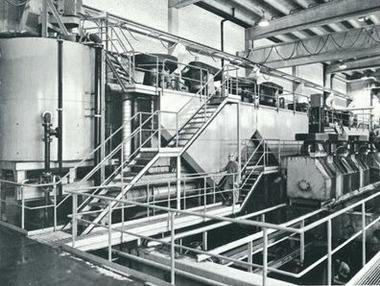Advantages of the massive 660 m³ flotation cell
With the need to address declining grades and the pressure to reduce capital costs as well as operational costs, original equipment manufacturers (OEMs) must continue to leverage technology to provide solutions for the mining industry. This is according to Frank Traczyk, director of flotation at FLSmidth, who says that the depth of expertise and experience that resides within the company allowed FLSmidth to progress flotation technology, and this culminated in the development of the new 600 Series SuperCell™ flotation machine. With an active volume of 660 m³, this massive cell is one of the world’s largest operating flotation cells and allows customers to take advantage of economies of scale.
The first 600 Series cell is installed at KGHM’s Robinson copper-molybdenum mine in Ely, Nevada/USA (Fig. 1). Initially water trials were conducted and when operators were confident with the results slurry was introduced and the cell was successfully commissioned in April 2015. Due to successful functioning of the cell following start-up, the plant’s operators were able to take over full operations after only 10 days with them reporting that the 600 Series cell “runs like it’s on autopilot.”
One of the primary advantages of the FLSmidth 600 Series SuperCell™ technology is the reduced flotation circuit area footprint. Comparing this unit, which offers a significantly higher flotation capacity, to the 300 m³ machine Traczyk says that it requires between 20 % to 30 % less area and can reduce CAPEX by up to 25 % and OPEX by 15 % (Fig. 2).
“Needing a smaller installation area makes it much easier and cost effective to retrofit these flotation machines into existing plants and also allows the footprint of new flotation circuits to be reduced resulting in infrastructure and construction savings of up to 25 % for the customer,” Harley Schreiber, flotation product manager at FLSmidth, explains. Schreiber says that process control in a flotation plant normally can be onerous with controlling slurry level and froth proving inherently difficult in a row of flotation cells. “The slurry level in any cell affects the driving head in adjacent cells and this can easily create unstable control conditions. This situation is exacerbated as larger concentrators with increased flotation cells are forced to use more cells per row,” he says.
The FLSmidth 600 Series SuperCell™, with half the number of flotation cells of smaller machines, offers a major advantage in terms of process control which facilitates more manageable control conditions on the plant (Fig. 3). The improved control inevitably results in improved metallurgical performance, according to Dariusz Lelinski, flotation development manager at FLSmidth. In addition to improved process control, maintenance requirements with its associated labour and time costs are reduced. “The maintenance crew can be mobilised to focus on only the single larger cell in some cases and economies of scale can also be applied to parts inventories, again resulting in decreasing operational costs for the plant,” Schreiber says.
With the growing need to optimise plants, this technology will allow additional rougher or cleaning capacity to be added to an existing circuit using a single a 660 mm³ cell. In this way the customer could easily increase the capacity or retention time of that particular row. The technology allows greater flexibility in terms of providing flotation solutions and allows various options to be considered to increase throughput or increase retention times. Specifically where a plant is able to reduce two streams into one, there are additional savings to be realised in terms of the entire installation as fewer blowers, samplers and pumps, for example, would be required.
“These savings would be both from a capital expenditure and operational cost perspective,” Lelinski says. The massive FLSmidth 600 Series SuperCell™ installed in Nevada, USA has been integrated as a rougher-scavenger in the copper flotation circuit without the need to add another line of flotation cells. The large flotation machine, which is about an 8.5 m high tank and nearly 11 m in diameter, offers significantly reduced specific power consumption (Fig. 4). By providing the necessary power in the critical contact region near the rotor, excellent metallurgical performance is ensured with less energy used overall.
“Importantly, the FLSmidth 600 Series SuperCell™ uses the same well respected FLSmidth flotation technologies and operators who are familiar with other flotation equipment will not have to change their operational approach,” Lelinski says. “This means it is possible to realise the inherent advantages of the massive machine almost immediately following installation and commissioning.”










